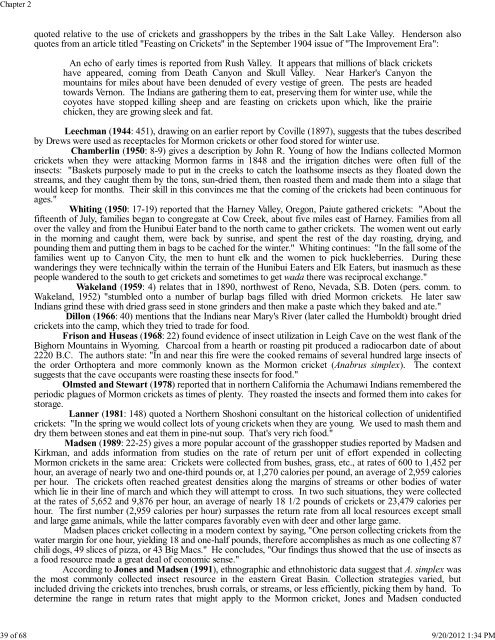Chapter 2. Insect Foods of North American Indigenous Populations ...
Chapter 2. Insect Foods of North American Indigenous Populations ...
Chapter 2. Insect Foods of North American Indigenous Populations ...
You also want an ePaper? Increase the reach of your titles
YUMPU automatically turns print PDFs into web optimized ePapers that Google loves.
<strong>Chapter</strong> 239 <strong>of</strong> 68 9/20/2012 1:34 PMquoted relative to the use <strong>of</strong> crickets and grasshoppers by the tribes in the Salt Lake Valley. Henderson alsoquotes from an article titled "Feasting on Crickets" in the September 1904 issue <strong>of</strong> "The Improvement Era":An echo <strong>of</strong> early times is reported from Rush Valley. It appears that millions <strong>of</strong> black cricketshave appeared, coming from Death Canyon and Skull Valley. Near Harker's Canyon themountains for miles about have been denuded <strong>of</strong> every vestige <strong>of</strong> green. The pests are headedtowards Vernon. The Indians are gathering them to eat, preserving them for winter use, while thecoyotes have stopped killing sheep and are feasting on crickets upon which, like the prairiechicken, they are growing sleek and fat.Leechman (1944: 451), drawing on an earlier report by Coville (1897), suggests that the tubes describedby Drews were used as receptacles for Mormon crickets or other food stored for winter use.Chamberlin (1950: 8-9) gives a description by John R. Young <strong>of</strong> how the Indians collected Mormoncrickets when they were attacking Mormon farms in 1848 and the irrigation ditches were <strong>of</strong>ten full <strong>of</strong> theinsects: "Baskets purposely made to put in the creeks to catch the loathsome insects as they floated down thestreams, and they caught them by the tons, sun-dried them, then roasted them and made them into a silage thatwould keep for months. Their skill in this convinces me that the coming <strong>of</strong> the crickets had been continuous forages."Whiting (1950: 17-19) reported that the Harney Valley, Oregon, Paiute gathered crickets: "About thefifteenth <strong>of</strong> July, families began to congregate at Cow Creek, about five miles east <strong>of</strong> Harney. Families from allover the valley and from the Hunibui Eater band to the north came to gather crickets. The women went out earlyin the morning and caught them, were back by sunrise, and spent the rest <strong>of</strong> the day roasting, drying, andpounding them and putting them in bags to be cached for the winter." Whiting continues: "In the fall some <strong>of</strong> thefamilies went up to Canyon City, the men to hunt elk and the women to pick huckleberries. During thesewanderings they were technically within the terrain <strong>of</strong> the Hunibui Eaters and Elk Eaters, but inasmuch as thesepeople wandered to the south to get crickets and sometimes to get wada there was reciprocal exchange."Wakeland (1959: 4) relates that in 1890, northwest <strong>of</strong> Reno, Nevada, S.B. Doten (pers. comm. toWakeland, 1952) "stumbled onto a number <strong>of</strong> burlap bags filled with dried Mormon crickets. He later sawIndians grind these with dried grass seed in stone grinders and then make a paste which they baked and ate."Dillon (1966: 40) mentions that the Indians near Mary's River (later called the Humboldt) brought driedcrickets into the camp, which they tried to trade for food.Frison and Huseas (1968: 22) found evidence <strong>of</strong> insect utilization in Leigh Cave on the west flank <strong>of</strong> theBighorn Mountains in Wyoming. Charcoal from a hearth or roasting pit produced a radiocarbon date <strong>of</strong> about2220 B.C. The authors state: "In and near this fire were the cooked remains <strong>of</strong> several hundred large insects <strong>of</strong>the order Orthoptera and more commonly known as the Mormon cricket (Anabrus simplex). The contextsuggests that the cave occupants were roasting these insects for food."Olmsted and Stewart (1978) reported that in northern California the Achumawi Indians remembered theperiodic plagues <strong>of</strong> Mormon crickets as times <strong>of</strong> plenty. They roasted the insects and formed them into cakes forstorage.Lanner (1981: 148) quoted a <strong>North</strong>ern Shoshoni consultant on the historical collection <strong>of</strong> unidentifiedcrickets: "In the spring we would collect lots <strong>of</strong> young crickets when they are young. We used to mash them anddry them between stones and eat them in pine-nut soup. That's very rich food."Madsen (1989: 22-25) gives a more popular account <strong>of</strong> the grasshopper studies reported by Madsen andKirkman, and adds information from studies on the rate <strong>of</strong> return per unit <strong>of</strong> effort expended in collectingMormon crickets in the same area: Crickets were collected from bushes, grass, etc., at rates <strong>of</strong> 600 to 1,452 perhour, an average <strong>of</strong> nearly two and one-third pounds or, at 1,270 calories per pound, an average <strong>of</strong> 2,959 caloriesper hour. The crickets <strong>of</strong>ten reached greatest densities along the margins <strong>of</strong> streams or other bodies <strong>of</strong> waterwhich lie in their line <strong>of</strong> march and which they will attempt to cross. In two such situations, they were collectedat the rates <strong>of</strong> 5,652 and 9,876 per hour, an average <strong>of</strong> nearly 18 1/2 pounds <strong>of</strong> crickets or 23,479 calories perhour. The first number (2,959 calories per hour) surpasses the return rate from all local resources except smalland large game animals, while the latter compares favorably even with deer and other large game.Madsen places cricket collecting in a modern context by saying, "One person collecting crickets from thewater margin for one hour, yielding 18 and one-half pounds, therefore accomplishes as much as one collecting 87chili dogs, 49 slices <strong>of</strong> pizza, or 43 Big Macs." He concludes, "Our findings thus showed that the use <strong>of</strong> insects asa food resource made a great deal <strong>of</strong> economic sense."According to Jones and Madsen (1991), ethnographic and ethnohistoric data suggest that A. simplex wasthe most commonly collected insect resource in the eastern Great Basin. Collection strategies varied, butincluded driving the crickets into trenches, brush corrals, or streams, or less efficiently, picking them by hand. Todetermine the range in return rates that might apply to the Mormon cricket, Jones and Madsen conducted
















